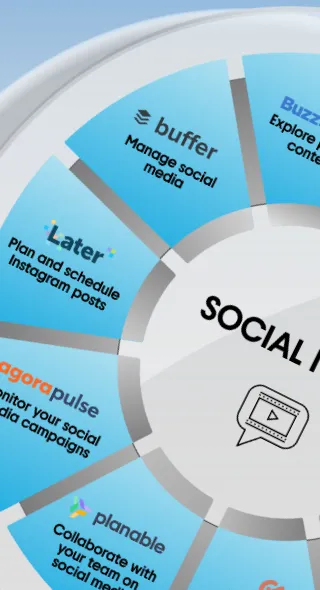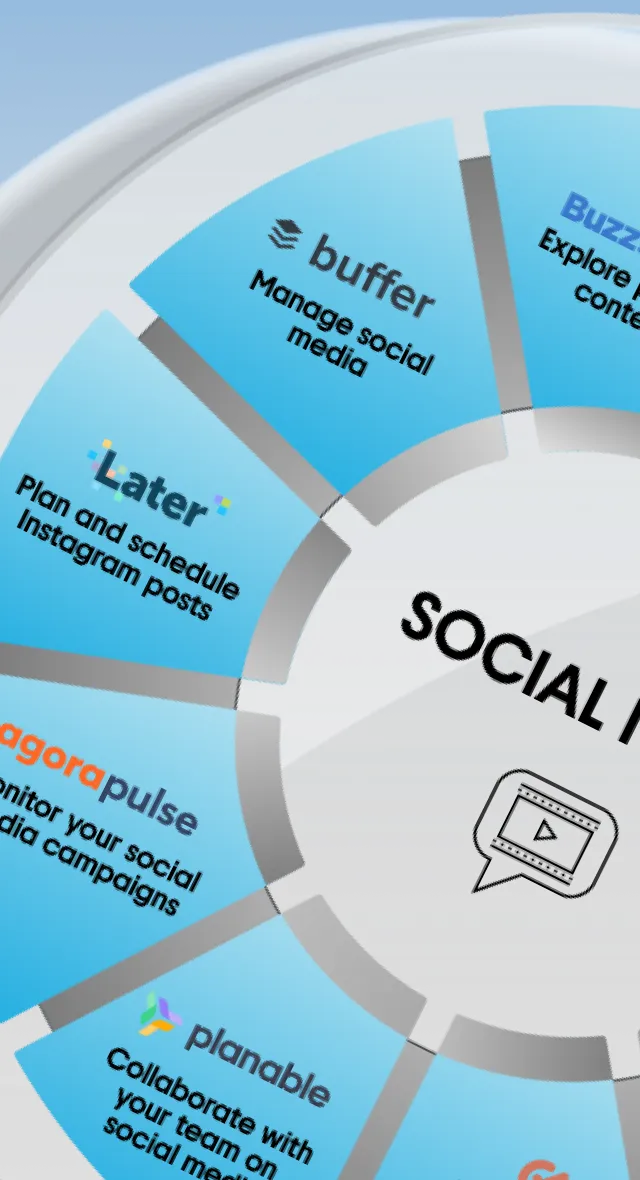40 Types of Marketing: Exploring Diverse Strategies for Business Success
One of the most important skills in a highly competitive business environment is the ability to adapt to changing market trends. At the same time, the marketing industry is developing so rapidly that it can be difficult to navigate through the huge selection of marketing methods.
To explore current practices and help you choose what’s right for your business, we’ve created a comprehensive guide to the most common types of marketing — from SMM and guerrilla marketing to niche and charity marketing. Check it out to find exciting ideas for building your brand!
Different types of marketing
1. Digital Marketing
Digital marketing (also called Internet marketing) is the promotion of goods and services using digital technologies at all stages of interaction with an audience. Its emergence and development became possible with the spread of technical advancements in the 1990s and 2000s. The Internet boom has changed many areas of our lives, including the way we do business and communicate. Today, 55% of all marketing activity takes place in the digital sphere.
The main advantages of digital marketing:
- ease of access due to the widespread use of the Internet,
- no binding to location,
- cost-effectiveness, and the possibility to track performance, segment an audience, and collect valuable data.
Want to stay up to date with the latest innovative approaches and maximize the effectiveness of your business strategy? Explore the eight key digital marketing trends in 2024—from hyper-personalization to the social-focused pricing revolution.
2. Traditional Marketing
Unlike digital marketing, traditional marketing uses the methods and channels that existed decades before the Internet. These primarily include newspapers, radio, television, and print advertising. Today, traditional marketing is not used as often, because the main interaction between brands and audiences takes place online. But it still has some advantages. For example, it’s a great option for those who want to reach an older audience, since baby boomers and partly Generation X are used to consuming information from TV. Traditional marketing is also suitable for promoting local location-based businesses.
3. Affiliate Marketing
Affiliate marketing (also called referral marketing) involves the cooperation of brands and individuals in promoting products or services. With this type of marketing, a company provides partners with unique links or promotional codes to use in advertising the company’s offers. Every time a customer makes a purchase through a link or redeems a promo code, the affiliate partner receives a certain percentage of the sale from the advertiser. This is effective and cost-efficient cooperation, as it is focused on specific, easy-to-measure results. In addition, affiliate marketing gives brands the opportunity to significantly expand their audience and promote products or services through various channels.
Looking for an additional source of passive income? Check out the Depositphotos referral program. By recommending our platform to your friends, colleagues, and partners, you can receive 40% cash rewards for their first purchases and 15% for their further purchases within three years!
4. Social Media Marketing
SMM (Social media marketing) is the use of social media platforms and the tools they provide to promote a brand or product. The main tasks of social media marketing are to increase company awareness, expand audience, drive traffic to websites, build a brand community, and communicate effectively with followers. Most social media platforms have built-in data analytics tools that allow you to track campaign performance metrics such as reach, likes, and shares.
Discover our articles with efficient approaches and tips on how to promote your business on the most popular social networks:
- Why You Need a Powerful Social Media Marketing Strategy in 2024
- How to Get Followers on Instagram: Your Comprehensive Guide to Organic Growth
- A Comprehensive Guide To Running TikTok Ads in 2024
- Finding the Best Times to Post on Social Media in 2024
5. Email Marketing
Email marketing is a way to promote a company, its products, and services through email campaigns. With this type of marketing, an email specialist compiles a customer database and prepares and sends emails with brand offers. Email marketing is considered one of the most effective approaches because it offers the highest return on investment (ROI): every dollar spent on email campaigns brings $36. It also helps build direct communication between a company and existing or potential customers, which, in turn, improves brand loyalty and increases sales in the long run.
Learn how to create compelling, eye-catching newsletters to help you successfully deliver your marketing messages. Explore our “Guide on Email Design: Best Practices and Examples.”
6. Content Marketing
Content marketing involves sharing interesting and relevant information to attract an audience and gain their trust. Here, marketers use high-quality valuable content that does not contain direct advertising but indirectly pushes the audience for the right decision. Key content marketing channels include websites, blogs, social media, print media, podcasts, webinars, and more. Sharing branded content allows, among other things, to familiarize the audience with brand offers, increase traffic, build a consistent company image, and increase direct sales.
Discover Depositphotos’ free AI tools to save time while creating visual content. Remove backgrounds from images and videos in a matter of seconds. Or, try Image Upscaler, which helps you not only enlarge pictures but also enhance their quality.
7. SEO Marketing
SEO marketing or search engine marketing is a set of activities aimed at improving the visibility of a website or its specific page in search engines. The main goal is to increase website traffic. SEO marketing methods include internal website optimization, which allows you to achieve better page rankings. One of the most effective approaches is external promotion, for example, online mentions in directories, joining aggregators, posting guest articles with links to your page, etc. In addition to increasing traffic, SEO marketing allows you to improve brand awareness, attract a target audience, and receive detailed analytics.
8. Influencer Marketing
Influencer marketing (also called influence marketing) involves a brand’s cooperation with opinion leaders to promote its products or services. The task of an influencer is to create engaging content which will introduce their audience to the brand’s products, discuss their benefits, and share their own (positive, of course) impressions. Influencer marketing is a very effective strategy, because influencers often have many loyal followers who trust their opinions. The main advantages of this strategy include its nativeness (usually, brands choose influencers from a relevant niche), as well as the ability to reach a target audience and gain new customers. In addition, today, brands can not only collaborate with live influencers, but also virtual ones.
9. Inbound Marketing
Inbound marketing is an approach to attracting potential customers by creating valuable content and sharing it through various channels. The key feature of inbound marketing is that you don’t try to win the audience’s attention with emails, calls, advertising, or other typical methods. Users come to your website or social media page just because they like your content. Due to this, you have a chance to drive traffic to your landing page, generate leads, and build strong customer relationships.
Creating content for different marketing channels and audiences doesn’t have to take up all your time. Discover the content repurposing approach, which allows you to significantly expand your reach while maintaining consistency.
10. Outbound Marketing
In contrast with inbound marketing, outbound marketing promotes a product through constant advertising, including various promotions, offers, and media coverage. In this case, it is the company that initiates personal contact with the audience and distributes the necessary messages. To do that, marketers use channels such as TV and radio, cold calls, mailings, SMS, exhibitions and workshops, etc. The main goal of outbound marketing is lead generation. It is especially effective in B2B and is well suited for older audiences who trust traditional advertising more.
Visual content is a powerful tool that helps you engage your audience and stand out from competition. Find out how to build an effective digital marketing funnel to drive sales or brand awareness in our article “How to Make a Lead with the Right Images: Sales Funnel Basics.”
11. Guerrilla Marketing
Guerrilla marketing is a set of creative and low-cost marketing activities intended to attract an audience and create buzz around a product. This type of marketing allows you to significantly save your budget. However, it requires a lot of time to prepare and launch campaigns, because to make it work well, you have to offer your audience a truly unique experience. Examples of guerrilla marketing include extraordinary promotions, viral videos, and exciting collaborations.
Want to create striking projects and make a lasting impression on consumers? Learn about the basic principles, tactics, and best practices of guerrilla marketing in our thematic article.
12. Brand Marketing
Brand marketing refers to marketing activities aimed at creating a certain image of a company or product in the mind of the audience. Its main goal is to distinguish a brand or product from competitors and make it a market leader. This marketing approach helps improve brand awareness, gain the trust of an audience, increase reach, and build a solid reputation. Using a well-thought-out brand strategy, a business can reach the next level, attract new customers, and increase sales as a result.
Modern consumers are becoming increasingly conscious and want to support brands that stand for specific values. Find out how social commitment can contribute to your business growth in our article “Building a Purpose-Driven Brand: Top Strategies and Insights.”
13. Video Marketing
Video marketing involves the use of video content to promote a brand, product, or service. The effectiveness of this approach is vividly demonstrated by one fact; more than 80% of marketers say that video helps them attract potential customers. Along with a high level of audience engagement, video marketing provides many other benefits including high ROI, increased conversion, improved traffic, and more.
Ready to explore the full potential of video? Discover the best practices for crafting a powerful social media video marketing strategy with inspiring examples from leading brands. And if you work in B2B, learn about seven types of videos that will skyrocket your ROI.
14. Product Marketing
This type of marketing is intended to launch a new product into the market and promote it. The main goal is to make the product popular among its target audience. To achieve this, experts conduct market research, analyze the audience, choose the best communication channels, and define goals and ways to convey the product’s value to potential buyers. If done correctly, product marketing helps make a brand and its product stand out from competitors, improve brand awareness, and generate leads.
To learn how to position and promote your product on the market effectively, and how industry leaders like Apple and Spotify implement this approach, read our article “What is Product Marketing for Industry Professionals?”
15. Experiential Marketing
Experiential marketing is a marketing activity aimed at evoking an emotional connection between consumers and a brand or product. This connection helps increase audience loyalty and directly influences the purchase decision-making process. By appealing to experiences and impressions, marketers can improve product memorability, evoke positive associations, and subtly push consumers to take action. Moreover, emotional engagement allows you to build strong and lasting relationships with your audience.
Are you looking for forms of audience interaction that will evoke a positive response from most users? Try gamification in marketing, which can boost engagement and bring seven times higher conversion rates.
16. Omnichannel Marketing
As the name implies, omnichannel marketing uses several channels to promote a brand’s goods or services. These can be websites, social media pages, emails, PPC, advertising, etc. Since each channel is intended for a specific audience, this approach helps increase reach. In addition, omnichannel marketing helps achieve higher conversion rates, faster promotion, better brand awareness, and audience loyalty.
17. Account-Based Marketing
Account-based marketing is a marketing approach that targets consumers who are most likely to become customers. Among other things, it involves finding target customers, identifying their main pain points, creating personalized messages, and performance analysis. This type of marketing allows you to meet the needs of consumers in the best way possible, which, in turn, helps build reliable and long-term relationships and expand the base of loyal, regular customers.
Learn more about the best approaches to account-based marketing! Maximize the impact of your efforts and effectively engage with customers who will likely bring you the most profit.
18. Growth Marketing
Growth marketing is aimed at finding the best way to grow a business through experiments. These include innovative solutions and A/B tests aimed at improving customer experience. In addition to experiments, growth marketing focuses on working on all stages of the sales funnel, improving product, and tracking trends.
Want to stay ahead of the competition when it comes to implementing cutting-edge marketing technologies? Discover transformative AI trends shaping the creative landscape. However, be sure to integrate intelligent solutions into your business processes thoughtfully, as they bring both benefits and risks.
19. Event Marketing
Event marketing involves the promotion of goods or services through arranging and holding special events. These can include exhibitions, workshops, conferences, training sessions, concerts, festivals, corporate events, etc. One of the main advantages of event marketing is direct contact with the audience, as it allows you to interest and attract potential customers. In addition, event marketing often brings direct sales of goods at events, if it is organically integrated into the context. This type of marketing is great for B2B, offering a chance to connect with customers on a personal level.
Join us at twelve global events to learn about the latest offers and updates, and discover new ways to bring your creative projects to life with Depositphotos.
20. Niche Marketing
In niche marketing, businesses try to attract a relatively small and strictly defined audience. The key to success in this case is choosing the right niche. For example, the clothing market is extremely large, but you can carve out a niche for yourself—for example, offering goods made from recycled materials. It’s also a great way to engage Millennials and Zoomers who consider environmental issues to be very important. Niche marketing is effective due to targeting, since it is aimed at an audience that is most likely to be interested in the brand’s product. This approach can significantly reduce marketing costs. Moreover, niches have much lower competition.
Learn about your target audience to better understand their needs and pain points, and discover how to communicate the right messages more effectively.
21. Words of Mouth Marketing
Words of mouth marketing, or WOM marketing, relies on the power of free native advertising sourced from customers. Simply put, it’s when satisfied users share their own reviews of certain products or services with their friends, acquaintances, or social media followers. Since they usually do not benefit from reviews, such recommendations are highly trusted by audiences. WOM marketing creates a positive brand image, builds a community around a brand, brings valuable feedback, provides effective reach, and increases sales. And it’s absolutely free, too.
Consumer reviews have a much more significant impact than advertising and can easily make or break your brand’s reputation. Find out how to get your products talked about positively with proven word-of-mouth marketing tips.
22. Relationship Marketing
This form of marketing is focused on establishing, maintaining, and developing long-term relationships with a company’s customers, partners, suppliers, and distributors. The main goal of this approach is to create an effective system of marketing interaction, that is to transfer communication with consumers to the level of personal relationships. The key principles of relationship marketing include creating additional value for the company’s product, an individual approach to each client, and a focus on retaining them.
Since personalization is the key to a successful customer experience, we recommend integrating this approach into your strategy. Not sure where to start? Discover our “Ultimate Guide to eCommerce Personalization” with helpful tools and tips that will allow you to stay competitive.
23. Cause Marketing
Cause marketing is a strategy in which a brand supports a certain non-governmental organization or charitable cause. For example, a company can donate a certain percentage of each purchase or promote a charity campaign through its channels. At the same time, charity marketing should be distinguished from charity; in charity marketing, the business still pursues specific goals, not just engages in philanthropy. This type of marketing allows you to improve your image, stand out among competitors, highlight your social responsibility, and gain the trust of your audience.
Discover the power of social commitment to not only improve customer reputation and loyalty, but also increase profits—read our article “Cause Marketing: Meaning, Benefits, and Top Strategies.”
24. Global Marketing
Global marketing is a set of marketing activities that target the international market. It is characterized by a standardized approach that is the same for all countries where the brand is represented. This means that all products, as well as their design, positioning, and marketing activities remain unchanged regardless of location. Many multinational companies like Coca-Cola and Apple choose this form of marketing. Global marketing saves time and money, since it focuses on universal solutions suitable for different markets. In addition, it provides an opportunity to improve brand awareness and maintains a consistent brand image.
25. International Marketing
Unlike global marketing, international marketing involves adapting the marketing strategy to each individual country where the brand is present, and sometimes even developing individual strategies. This can include creating products for a specific market, engaging local marketing specialists, and establishing localized communication. A vivid example of using international marketing principles is the business activity of McDonald’s. This company always adapts its range depending on the country. This customized approach allows them to significantly expand their audience, attract new customers, and improve customer engagement.
26. Viral Marketing
In viral marketing, a brand or product is promoted by distributing viral content. Moreover, such content is distributed by users themselves, creating a hype effect. Viral marketing does not use direct advertising or calls to action. It is aimed at wide reach, improving brand awareness and memorability, and building a certain image. Most often, this type of marketing uses videos, memes, funny advertising campaigns, contests, and promotions.
27. Conversational Marketing
Conversational marketing is based on real-time communication that helps engage website visitors and guide them on the path to purchase. This approach uses chatbots and online chats to communicate with users. This ensures a high level of customer service and builds long-term relationships by meeting the customers’ needs. Other pros of conversational marketing include a more personalized approach, higher conversion rates, the possibility to obtain valuable user data, and effective lead generation.
Nowadays, chatbots are indispensable assistants in a wide variety of tasks. Are you looking to simplify your creative process or plan your time more efficiently? Explore the best chatbots for work, fun, and education.
28. Stealth Marketing
Stealth marketing, also called undercover or buzz marketing, is designed to promote products in a non-obvious way. The key feature of this approach is its ability to engage an audience without them realizing it. To achieve this, marketers typically use unconventional channels and methods, and create an atmosphere of mystery around a brand. Forms of stealth marketing can include product placement, collaborations with influencers, or sharing user-generated content. This is a great way to increase organic reach, improve brand awareness, and even attract new customers. In addition, it is relatively inexpensive.
29. Nostalgia Marketing
In nostalgia marketing, the main role of promoting goods or services is assigned to stimuli that evoke pleasant memories in the audience. By appealing to a sense of nostalgia, marketers can draw the attention of users, gain their trust, and build strong relationships. But to use this approach, it is essential to know your audience, its psychographic characteristics, values, and beliefs. This will help you find out what events, ideas, or figures from the past can make you feel nostalgic. If done correctly, nostalgia marketing can bring many benefits, from improved loyalty to strengthening your brand’s position in the market.
Learn how to leverage the power of memories to create captivating campaigns and engage your audience effectively using nostalgia marketing.
30. Data-Driven Marketing
Data-driven marketing is a marketing approach that uses data to develop marketing strategies. It is based on collecting and analyzing data from various sources, including websites, newsletters, social media, and other channels. This information allows you to gain insight into customer behavior and preferences, carry out quality audience segmentation, and create targeted campaigns that are more likely to resonate with users. Data-driven marketing is a cost-effective approach that enhances customer experience and improves products.

31. Trigger Marketing
The bedrock of trigger marketing is an understanding of consumer psychology. This approach uses special techniques (triggers) that stimulate a person to perform a desired action, such as making a purchase, making a phone call, or leaving a contact. Triggers can be emotional (fear, hunger, happiness, love, etc.), behavioral (page viewing, incomplete purchase), event-based (various holidays and special events), and engagement-oriented (reactions to a subscription, comment, or inactivity). Trigger marketing allows you to set up automated communication characterized by a high level of personalization, relevance, and timeliness. It’s a great way to connect with customers and encourage them to take desired action.
32. Print Advertising
The use of printed materials for business purposes is often singled out as a separate type of marketing. The most popular print formats include billboards, posters, flyers, brochures, product packaging, business cards, and media publications. Print advertising is less intrusive than targeted online messages, which is a big advantage. In addition, it helps improve brand competitiveness, awareness, and memorability and offers consumers a unique sensory experience. It is also worth noting that printed materials are durable, so they can reach a larger audience.
Discover the potential of posters as a tool for promotion, raising awareness, spreading messages, and more. Find the best practices for designing stunning pieces in our article “How to Create a Poster Design in 2024: Pro Tips & Inspiring Examples.”
33. Engagement Marketing
Engagement marketing, also called participation or loyalty marketing, is focused on promoting a product or service through a memorable customized experience that creates emotional attachment. In this approach, customers are not passive recipients of messages, but rather active participants in brand development. Examples of engagement marketing include campaigns that evoke a sense of community, gamified experiences, or virtual events. This exciting interaction helps maintain a high level of engagement, convert users into customers, and improve customer loyalty.
Are you looking for ways to build meaningful connections with your audience? Invest in powerful storytelling that can revolutionize your brand’s communication.
34. Multicultural Marketing
Brands that use multicultural marketing aim to meet the needs of customers from different ethnic and cultural groups. This approach is especially important for global companies seeking to maintain diversity and build strong relationships with different segments of their audience. Multicultural marketing is based on a deep understanding of the cultural experiences of the groups targeted. Ethnicity-oriented campaigns provide an opportunity to expand clientele, gain target audience affection, and ultimately increase sales.
35. Green Marketing
Green marketing implies that a company’s activities across all stages — from product development and manufacturing to promotion and disposal — comply with the principles of sustainable development. By practicing this approach, brands can reduce energy consumption, use recycled materials, create recycling programs, and launch various green initiatives and campaigns. Positioning your company as a socially responsible brand allows you to create a positive image, stand out from the competition, and attract potential customers.
36. Contextual Marketing
Contextual marketing refers to an approach where users receive marketing content like emails, offers, or advertisements at specific moments of interaction with a brand. Its main principle is to deliver the right content, to the right people, at the right time. Unlike content marketing, to deliver a message, contextual marketing uses specific timing and circumstances. If you make it in a timely and relevant manner, you can expect a higher level of customer satisfaction and better conversion.
37. Native Marketing
In native marketing, all advertising messages organically fit into non-advertising content. As a result, native advertising is perceived by an audience as useful information and does not cause a negative reaction. This approach focuses on the needs of the client, which is why native advertising always has a certain value. These can be articles, videos, guides, tests, podcasts, and special projects that contain interesting information or information to solve specific problems. It’s a great way to promote a product in a subtle way, which gives you a high CTR, and improves brand awareness and trust.
38. Proximity Marketing
Proximity marketing is a strategy that uses geolocation technologies to send users marketing messages. In other words, it’s when you send ads to people who are close to you using Wi-Fi, Bluetooth, NFC, or GPS. This type of marketing involves creating targeted offers based on user preferences. Its advantages include better engagement, high conversion rates, and the opportunity to obtain useful data about your audience.
39. Integrated marketing
With integrated marketing, a brand distributes consistent messages across all of its channels. This approach allows you to achieve consistent customer interaction, because different types of marketing, including email marketing, SMM, SEO, and PPC work together in the same direction. The use of a consistent visual style and tone of voice is an essential component of an integrated marketing campaign. This contributes to brand awareness, a more efficient distribution of marketing messages, and also improves customer experience.
40. B2B, B2С, and B2D marketing
B2B marketing refers to the process of interaction between two companies. As a result, one of them sells goods or services to the other. This is a key difference from B2C marketing, where all activities are aimed at individual customers. B2B marketing is focused on establishing strong, long-term relationships with a longer sales cycle and larger sale amounts. While B2C marketing is aimed at attracting a large number of customers and making frequent and small purchases. One of the new trends gaining momentum is B2D marketing (Business-to-developer), which is the promotion of products or services for software developers and IT professionals.
To wrap up
There is no one perfect marketing approach that will meet all of your needs. The market is constantly evolving, changing under the influence of social, economic, and cultural events. For this reason, brands have no choice but to be flexible. If you want to improve your competitiveness and achieve your key business goals, combine different marketing types. Don’t be afraid to experiment and try bold solutions to stay one step ahead!
Other articles on similar topics:
Creating a Marketing Plan: Steps, Types & Expert Tips
Leadership Styles Demystified: Finding Your Path to Success
10 Best Data Visualization Tools and Techniques in 2023














